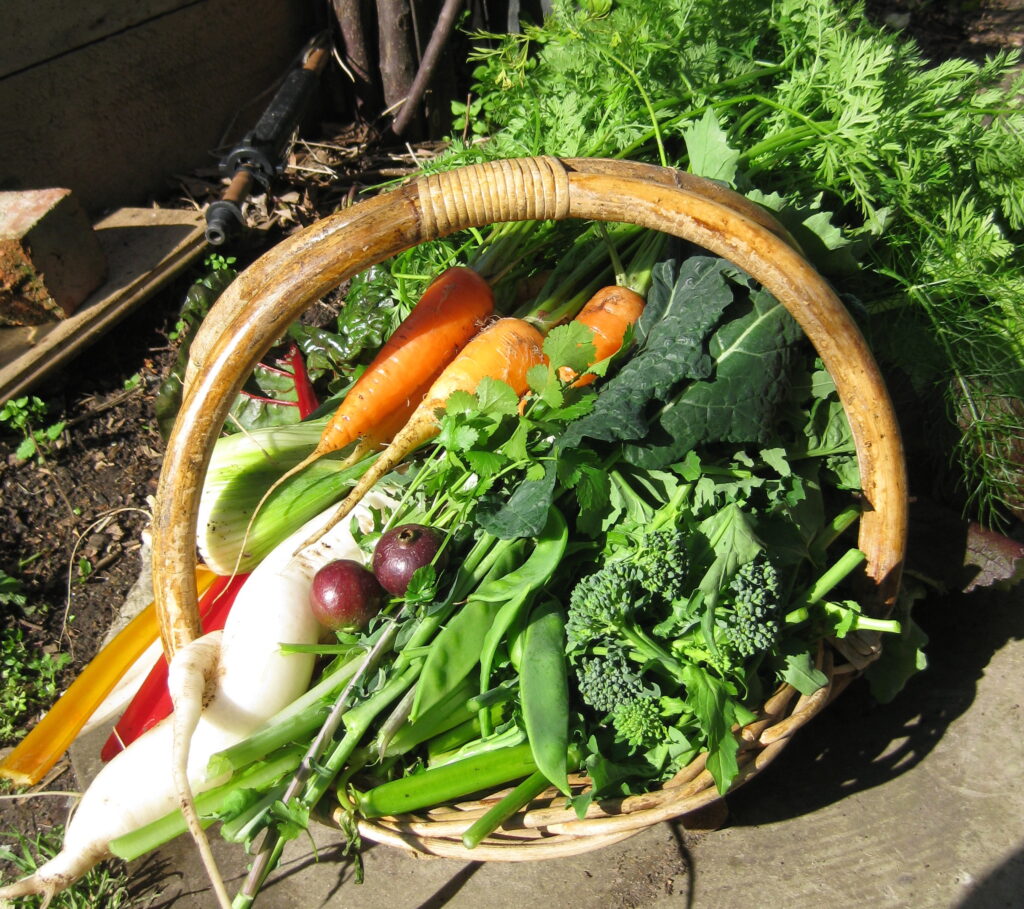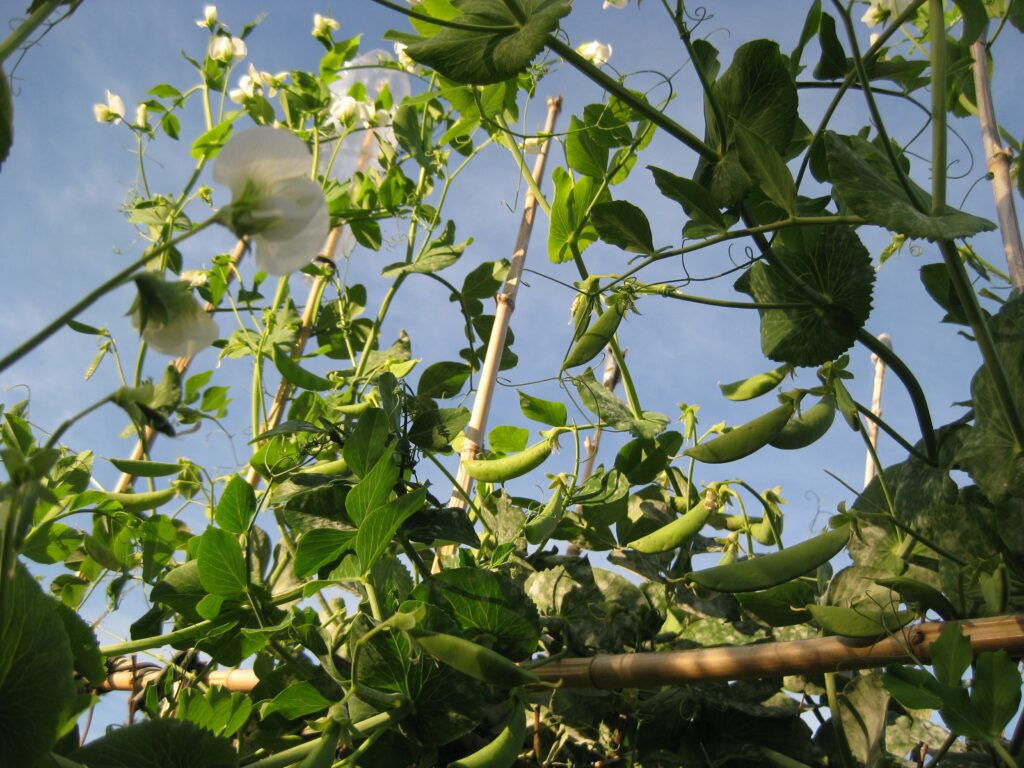Your cool season vegie patch
Notes prepared by Kat Lavers, September 2022

While you might not feel like spending much time outside during the cooler, darker months of the year, winter in Victoria is actually one of the easiest times to grow vegies. Many of our common pests like cabbage white butterflies are less active or dormant (or at least not breeding so fast!), there’s lower irrigation demand and no heatwaves to wilt you or your plants.
Design for cold conditions
When the weather is cold you won’t want to walk through long, wet grass or venture to the back of your garden – so keep your vegie patch as close to the kitchen as possible while still maintaining excellent sunlight. Protection from cold winds is important too (generally from a S or SW direction). If your soil is heavy clay you may need to raise beds for better drainage. Greenhouses, cold frames, cloches or simply reused clear plastic sheeting on hoop frames can also be used to warm up conditions for beds or individual plants.
Frost is rarely a problem in built up urban areas, but if it happens where you live, site your patch away from frost pockets, surround it with thermal mass (rocks, bricks, water tanks, pond), mulch heavily or grow frost-resistant vegies.
Dealing with the last of your warm season crops
Some of your summer vegies will continue to grow in colder weather – so don’t pull them out. Capsicums and chillis will usually produce until mid winter, and some will overwinter and fruit even better the following year. Basil often produces well until very cold weather arrives as long as flower buds are pinched out. Spring onions, celery, carrots, beetroot and silverbeet can be harvested until warmer weather arrives in spring. Tomatoes can be pulled out and hung up – the unripe fruit will continue to draw some energy from the vines, and many green fruit will ripen.
It’s all in the timing
One of the most important factors if you want to eating homegrown vegies over winter is planting them at the right time. Broccoli planted in late autumn may not be ready to harvest until spring, just when you need the bed clear for tomatoes. Cold weather and reduced sunlight dramatically slow growth, so you need to give them time to grow while the weather is still warm. Many slow-growing vegies need seeds planted in February and seedlings in March for harvest from May. Use the table in these notes as a rough starting point but keep a garden diary to refine timing in future years.
Preparing your soil
To grow strong, nutritious vegies you need healthy, nutrient-packed soil. Remove and compost previous plants (or simply cut them down and leave as mulch on the surface), gently aerate the soil using a garden fork and mix 3-5 cm of compost into the top few inches, and spread around existing plants. Heavy feeding winter vegies like brassicas (broccoli, cabbage, kale etc) will enjoy some extra nitrogen (eg. blood and bone, poultry manure – try a handful per m2).
Cool season vegetables and timing
| Vegetable | When to sow seed for winter harvest | Punnets or sown direct? | Notes |
|---|---|---|---|
| Beetroot | November – March | Direct or Punnets | If sown in punnets, must be planted out very gently when the first or second set of true leaves emerges to avoid damage to roots. Use leaves as cooked greens. |
| Broccoli | January – February | Punnets | Sprouting varieties provide longer harvest and have tender leaves and stems for cooked greens. Purple varieties may not produce shoots until spring. |
| Brussels spouts | January – February | Punnets | Requires long growing season so must be planted in summer |
| Cabbage | January – February | Punnets | Won’t form heads if shaded so give them your sunniest position |
| Carrots | August – February | Direct | Lay an old blanket over the seeds while germinating to give even temperature and maintain soil moisture. For large carrots in winter, sow enough for the whole year in spring as they store well in the ground. |
| Cauliflower | January – February | Punnets | Requires long season – may not produce heads until late winter but will grow rapidly when they finally appear |
| Coriander | February – April | Direct | Much easier to grow in cooler weather as it won’t bolt to seed. Sow direct to avoid disturbing taproot as this also leads to bolting. Use the roots in your cooking as these are packed with flavour. |
| Daikon radish | March – April | Direct | Harvest some leaves for salad or cooked greens, then later use mild, giant roots for cooking, pickling or grated fresh in salads. |
| Fennel | February – April | Direct or Punnets | Edible bulbs, leaves, stems, flowers, seeds, plus roots that taste like parsley/parsnip. Attracts beneficial insects when flowering. |
| Kale | January – February | Punnets | Leaves become sweeter after frost. |
| Leeks | August – January | Punnets | Take a long time to reach edible size – perennial leeks are an easier option. Eat the whole vegetable by chopping green leaves finely and cooking those first for slightly longer than the white stem. |
| Lettuce | February – March | Punnets | Less likely to bolt to seed in cooler weather, plant a few seeds every 2 months for a continuous supply. |
| Mizuna | February – March | Direct | Fantastic, hardy salad green. Great alternative to lettuce |
| Mustard | February – March | Direct | Red varieities grow well in shadier positions. Slice young leaves finely in salad, or cook to remove heat. |
| Peas/Snow peas | February – April | Direct | Climbing peas can grow to 2m and need support structure. Look for varieties with edible pods for a better yield. |
| Radicchio/Chicory | February – March | Punnets | Bitter greens for salads or cooking. |
| Radish | February – April | Direct | Quick crop – some varieties ready in 30 days. Use leaves as cooked greens. |
| Rocket | February – March | Direct | Less likely to bolt to seed in cooler weather, plant a few seeds every 2 months for a continuous supply, or grow wild rocket instead. |
| Silverbeet | August – March | Punnets or direct | Will produce greens for a whole year if planted in spring and well fed. Top up compost in autumn. |
Notes:
- If buying seedlings, add about 6-8 weeks to these sowing times for approximate planting time.
- Many of the ‘weeds’ in your winter garden have a long history of culinary use (eg. nettles, chickweed and dandelion) but be certain that you know how to identify them correctly.
- Winter is also a planting season for broad beans, onions and garlic that will be harvested in spring and summer.
- Don’t forget perennial vegetables that can fill harvest gaps and reduce work: some examples for late autumn and winter harvest are chokos, wild rocket, sorrel, perennial leeks, Jerusalem artichokes.
Do I need to water?
During the cooler months there is less demand for water, but you may still need to irrigate occasionally if soil moisture is low. Wet leaves and mulch can be very misleading – the best gauge is to stick your finger into the soil about 10cm, and if it feels dry then it’s time to water.
What about mulch?
While mulch is most helpful in summer to reduce moisture evaporation and protect soil from UV, mulch is also useful in the cooler months to keep your soil warmer, suppress weeds and protect from compaction and erosion caused by heavy rain. Use soft organic mulches like straw and leaves that will feed your vegies and beneficial soil microorganisms as they break down. They may also harbor slugs and snails, and in early spring mulched soils warm up more slowly. I generally maintain a thin layer of mulch in winter, keeping it away from young seedlings until they are established and removing briefly in spring to sow seeds and allow soil to warm up.

Take a break with green manures
If you don’t want to grow winter vegies, or only want to use a section of your vegie beds, green manure crops will maintain and improve the condition of your soil while you take a break. Green manures protect soil from sun, rain, erosion and leaching and inhibit weeds. They also provide a nutrient boost for your next crop by building organic matter and some species (eg. peas, beans, vetch) will fix nitrogen in the soil. You’ll get the maximum soil fertility boost by cutting back when they begin to flower and forgoing any harvest of peas or beans. You can cut down the green manure crop and either dig in, or leave on the surface as mulch for the next season’s crops. Some examples of cool season green manure plants are broad beans, vetch, winter wheat, oats and peas.
Happy gardening!


